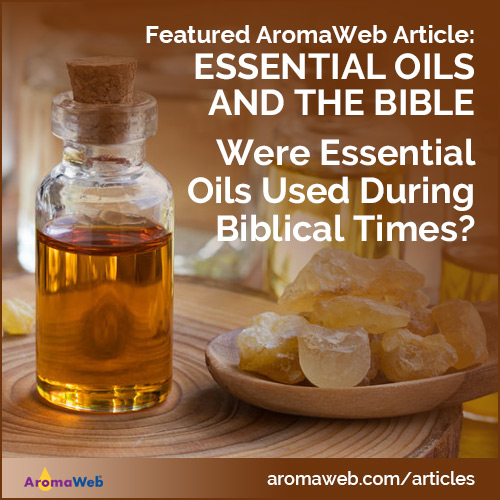Essential Oils and the Bible

Were Essential Oils Used During Biblical Times?
Probably not.
As the Aromatic Botanicals, Aromatherapy and the Bible page states, the Bible is rich in references to aromatic plants, aromatic oils and anointing oils. The aromatic and anointing oils mentioned throughout the Bible were likely to be what we refer in modern times as infused oils, not essential oils.
Essential oils are produced via steam and hydro distillation. If any stills were in existence during Biblical times, they were probably only capable of producing hydrosols.
Within the second edition of Essential Oil Safety, Robert Tisserand and Rodney Young state the following:
"Aromatic plants and infusions prepared from them have been employed in medicines and cosmetics for many thousands of years, but the use of distilled oils [the method used to produce essential oils] dates back only to the 10th century, when distillation as we know it today was developed."1
What About All the People That Say Essential Oils are Mentioned in the Bible?
There are individuals that do strongly believe that the aromatic oils mentioned in the Bible are essential oils. I would find that very special myself if were true, but I believe that is very unlikely. The frequent claim that essential oils were used in Biblical times may have begun due to people not understanding what essential oils are and how they are produced. Over and over, I've seen people get confused and think that any oil that is aromatic is defined as an essential oil. For an aromatic oil to be properly referred to as an essential oil, it must be distilled (or in the case of citrus essential oils, the citrus oils can be either distilled or cold pressed). Infused oils, absolutes, CO2 extracts, and other aromatic oils are not essential oils and should not be called essential oils.
All of these different types of aromatic oils have wonderful applications and I'm not trying to discount that. In addition to essential oils, I love infused oils, CO2 extracts and absolutes and work with them regularly. My point is that infused oils, CO2 extracts and absolutes should not be referred to as essential oils. That can cause confusion. When you are shopping for essential oils or other particular aromatic oils, it is best to doublecheck the method of extraction so you can confirm that what you are purchasing is indeed what you are expecting. Sometimes absolutes and CO2 extracts are listed amongst essential oils in books and Websites and that's ok if each individual aromatic is clearly denoted as an absolutes, CO2 extract, etc.
Was Baby Jesus Given Frankincense Essential Oil or Myrrh Essential Oil?
I've seen comments that baby Jesus was given Frankincense Essential Oil and Myrrh Essential Oil. That would be rather unlikely. Jesus was probably presented with frankincense and myrrh resins. These resins are beautifully aromatic, were used in medicinal, incense, burial and spiritual applications.
What was the Nard Perfume / Ointment That Mary Applied to Jesus Feet Made From?
The New Testament Gospels tell of how Mary anointed Jesus' feet with a precious perfume or ointment made using nard. It is believed that the Nard mentioned in this account may be what we today know as the plant Spikenard (Nardostachys jatamansi).2
I've read translations that almost sound like the ointment or perfume was made using only Spikenard. Some readers then take it a step further and state that it was Spikenard Essential Oil that Mary applied to Jesus' feet. I personally don't agree with that belief for the reasons I mention above. I believe that the oil/ointment was probably an infused oil that was made using olive oil and a significant quantity of pure spikenard roots. The resulting infused oil would likely have been extremely fragrant with the aroma of the nard. Salvatore Battaglia indicates that during Biblical times, the spikenard likely came from India.3 I can imagine how costly the ointment was due to the costs associated with harvesting the spikenard, preparing the ointment (which was probably a lengthy process), packaging and transporting it.
"Then Mary took about a pint of pure nard, an expensive perfume; she poured it on Jesus' feet and wiped his feet with her hair. And the house was filled with the fragrance of the perfume."
— John 12:3 (NIV)"Mary then took a pound of very costly perfume of pure nard, and anointed the feet of Jesus and wiped His feet with her hair; and the house was filled with the fragrance of the perfume."
— John 12:3 (NASB)"Then took Mary a pound of ointment of spikenard, very costly, and anointed the feet of Jesus, and wiped his feet with her hair: and the house was filled with the odour of the ointment."
— John 12:3 (KJV)
We shouldn't be disappointed that it's unlikely that essential oils were used during Biblical times. We can still greatly appreciate the aromatic plants and oils that were mentioned in the Bible. Infused oils are remarkable to work with, and they make a beautiful complement to essential oils.
For More Information About the Aromatic Plants Mentioned in the Bible and Infused Oils
For more information, please read the following articles:
- What are Infused Oils (also Known as Macerated Oils)?
- Aromatic Plants Mentioned in the Bible
- Aromatic Botanicals, Aromatherapy and the Bible
- Praying With Essential Oils
References
1 R.J. Forbes, A Short History of the Art of Distillation, 1970. E J Brill, Leiden. As cited in Robert Tisserand and Rodney Young, Essential Oil Safety: A Guide for Health Care Professionals (Second Edition. United Kingdom: Churchill Livingstone Elsevier, 2014), 5.
2 Valerie Ann Worwood, Aromatherapy for the Soul (Novato, CA: New World Library, 1999, 279.
3 Salvatore Battaglia, The Complete Guide to Aromatherapy Third Edition Volume 1 - Foundations & Materia Medica (Brisbane Australia: Black Pepper Creative, 2018), 540.
